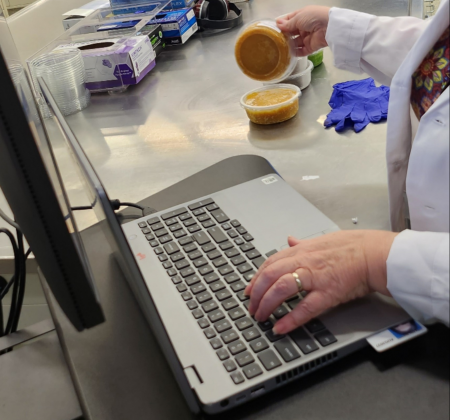New Digitized “Cloud” Helps FDA Scientists Share Findings Almost Instantly, Advancing Consumer Protections and Food Safety
Accuracy is at the heart of all FDA science—and the unwavering standard for 15 laboratories at 12 locations housed in the agency’s main field operations office, the Office of Regulatory Affairs, or ORA. In addition to accuracy, though, the consumer protection agency also demands speed and resiliency in its daily operations to shield Americans from unsafe foods, drugs, and other consumer goods—especially during foodborne illness outbreaks and other public health emergencies.
No one understands this more acutely than the scientists and analysts working at ORA’s laboratories, who are tasked with testing thousands of food, drug, veterinary, and other samples each year. While their work is complex, multi-step, and often repetitive, their goal remains constant: to ensure that unsafe consumer foods and medical products—ranging from salad mixes tainted with illness-causing Listeria, to pesticide-laden fruits and vegetables, to fraudulent drugs—are removed swiftly from commerce, or better yet never allowed to enter U.S. grocery stores, drugstores, and other markets in the first place.
Now with the help of a custom application hosted in a cloud environment called ALIS—short for Automated Laboratory Information System and designed in partnership with REI Systems, a company that specializes in finding IT solutions for federal government agencies—ORA lab staff are able to work even smarter and more swiftly, entering data into a system that instantly and simultaneously coordinates and shares critical lab findings with the FDA teams poised to take the necessary regulatory actions to protect the public.
Morgan Carrasquillo, a ten-year veteran, and chemist with ORA, who has worked on the project since its inception, is excited to see real success with information technology modernization efforts, a top priority for the FDA. Carrasquillo has lent her everyday laboratorian insights to the project, helping her IT teammates envision a highly functioning data system that also keeps the needs of scientists and other users front of mind.
With ALIS, upon completion of sample testing, ORA analysts can now enter data right from the bench, reducing the need to head back to the office to complete dense paperwork, then upload to online databases. Carrasquillo likens the new ease of use to a doctor wheeling a laptop on a cart into a room with a patient, entering information, even a drug order, all while a patient is still talking. “Through this great partnership between our labs, REI, and our FDA IT teams,” she says, “we’re one step closer to realizing a fully electronic workplace, which is our ultimate goal.”
Entering data as a result of lab work can be very laborious, so a more hastened data entry process gives precious time back to scientists so that they can return to the vital work of receiving, prepping, and assessing samples. The initial project for ALIS focused on ORA’s 5 laboratories that conduct pesticide and industrial chemical testing on human food and animal feed. To illustrate the steps involved, and efficiency that digitization offers, take, for instance, an analysis of peppers, which are regularly tested by ORA lab staff for unlawful pesticides.
A lab might receive a sample from an ORA field investigator who is on site conducting a routine inspection at a farm or food processing facility. The receiving lab analyst must first inspect the sample, then prepare it for extraction. For peppers, that could mean removing seeds and grinding the sample into a slurry, and then adding solvents to liquify those solids for optimal scrutiny. Next, a portion of the extract is injected onto an instrument that has been programmed by ORA scientists to scan for upwards of 900 different pesticide and industrial chemical residues. If a prohibited, and potentially harmful, residue is found, then further testing is done for confirmation and to identify, at a minimum, a parts-per-million (ppm) figure of contamination.
Now, armed with ALIS, lab work is more automated Findings can be swiftly uploaded, important regulatory documents completed and verified, and data instantly made available to agency teams executing compliance—as well as to imports teams screening foods and drugs at the border, and regulatory partners working hand in hand with the FDA to promote public health at state, local, tribal, and territorial levels. Thanks to ALIS, ORA lab staff say lab results are being dispersed more quickly to those responsible for initiating a recall or removing a harmful product from commerce--in some cases, in about half the time it used to take.
“The ability to compile and access so much data in one spot has been tremendous,” says Dr. Paul Norris, director of ORA’s Office of Regulatory Science. “Our lab staff already work tirelessly to deliver findings in service to public health. Having a tool that supports them, and adds efficiency and cost-savings, is a real game-changer.”
Norris adds that ORA is also excited about the prospects of tapping the secure cloud-based data system for artificial intelligence and other data-combing technologies currently in development. This would facilitate a greater orchestration of regulatory activities and functions across the country and even globe. And it further enables the goal of more predictive actions that can prevent harmful products from ever entering supply chains and reaching consumers.
The agency is not alone in its praise of the new technology. The ALIS project has been named a FedHealthIT 2023 Disruptive Tech Program Award winner, among others during a ceremony held on April 12. Winners are acknowledged for being federal IT innovators, positively transforming how government fulfills its important missions in serving the nation.

